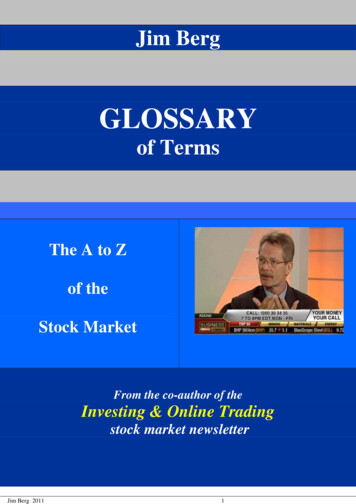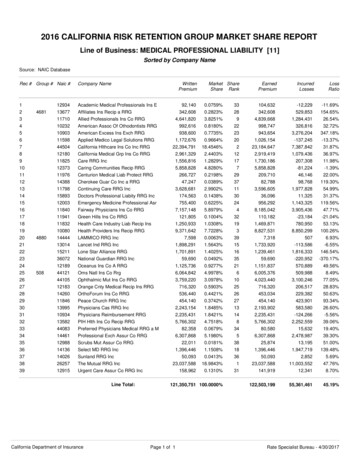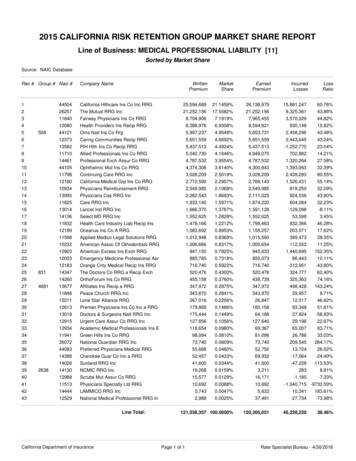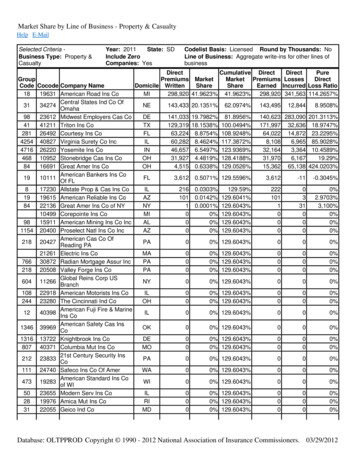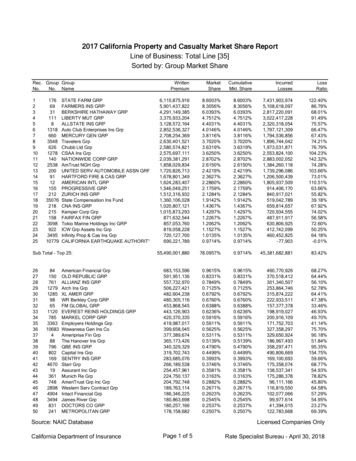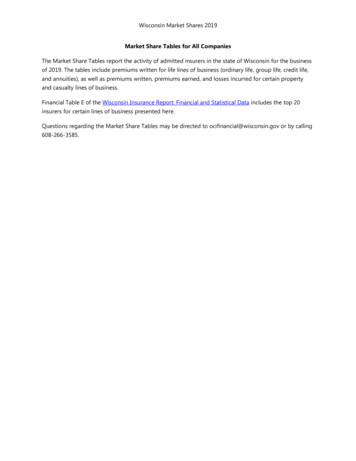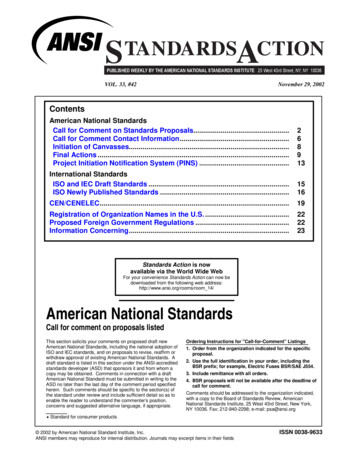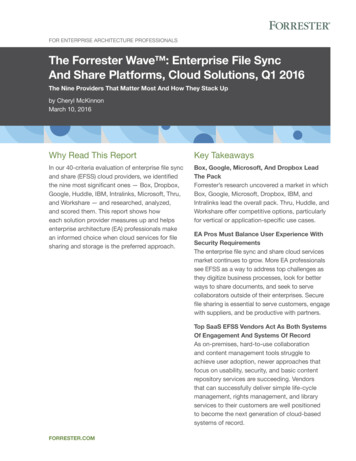
Transcription
MARKET-SHARE ANALYSIS
International Series in Quantitative MarketingEditor:Jehoshua EliashbergThe Wharton SchoolUniversity of PennsylvaniaPhiladelphia, Pennsylvania, U.S.A.
Market-Share AnalysisEvaluating Competitive Marketing EffectivenessLee G. CooperAnderson Graduate School of ManagementUniversity of California, Los AngelesMasao NakanishiSchool of Business AdministrationKwansei Gakuin UniversityNishinomiya-shi, JAPANKluwer Academic PublishersBoston Dordrecht London
Distributors for North America:Kluwer Academic Publishers101 Philip Drive, Assinippi ParkNorwell, Massachusetts 02061 USADistributors for the UK and Ireland:Kluwer Academic PublishersFalcon House, Queen SquareLancaster LA1 1RN, UNITED KINGDOMDistributors for all other countries:Kluwer Academic Publishers GroupDistribution CentrePost Office Box 3223300 AH Dordrecht, THE NETHERLANDSLibrary of Congress Cataloging-in-Publication DataCooper, Lee G.Market-share analysis: evaluating competitive marketing effectiveness / Lee G. Cooper, Masao Nakanishi.p.cm. – – (International series in quantitative marketing)Bibliography: p.Includes index.ISBN 0–89838–278–51. Marketing – – Decision making – – Mathematical models.I. Nakanishi, Masao, 1936–. II. Title. III. Series.HF5415. 135.C66 1988658.8‘02 – – dc 1988–12092CIPOriginal Copyright c 1988 by Kluwer Academic PublishersCopyright c 2010 by Lee G. CooperAll rights reserved. Printed in the United States of America
ContentsList of TablesxList of FiguresxiiForeword . . . . . . . . . . . . . . . . . . . . . . . . . . . . . . xiii1 Scope and Objectives1.1 Interest in Market-Share Analysis . . . . . .1.2 Need for a Analytical Framework . . . . . .1.3 The Process of Market-Share Analysis . . .1.3.1 Stage 1: Specification of Models . .1.3.2 Stage 2: Data Collection and Review1.3.3 Stage 3: Analysis . . . . . . . . . . .1.3.4 Stage 4: Strategy and Planning . . .1.3.5 Stage 5: Follow-Up . . . . . . . . . .2 Understanding Market Shares2.1 Market Shares: Definitions . . . . . . . . . . . . . . .2.2 Defining Industry Sales . . . . . . . . . . . . . . . . .2.3 Kotler’s Fundamental Theorem . . . . . . . . . . . .2.3.1 A Numerical Example . . . . . . . . . . . . .2.4 *Market-Share Theorem . . . . . . . . . . . . . . . .2.5 Alternative Models of Market Share . . . . . . . . .2.6 Market-Share Elasticities . . . . . . . . . . . . . . .2.7 Sales-Volume Elasticities . . . . . . . . . . . . . . . .2.8 *Market Shares and Choice Probabilities . . . . . . .2.9 Appendices for Chapter 2 . . . . . . . . . . . . . . .2.9.1 *Calculus of Market-Share Elasticities . . . .2.9.2 *Properties of Market-Share Elasticities . . .2.9.3 *Individual Choice Probabilities . . . . . . .2.9.4 *Multivariate Independent Gamma 454652
viCONTENTS3 Describing Markets and Competition3.1 Market and Competitive Structure . . . .3.2 Asymmetries in Market and Competition3.3 Differential Effectiveness . . . . . . . . . .3.4 Differential Cross Elasticities . . . . . . .3.5 Properties of Fully Extended Models . . .3.6 Determining Competitive Structures . . .3.7 Hierarchies of Market Segments . . . . . .3.8 Distinctiveness of Marketing Activities . .3.9 Time-Series Issues . . . . . . . . . . . . .3.10 Appendix for Chapter 3 . . . . . . . . . .3.10.1 *Log-Linear Time-Series Model . .4 Data Collection4.1 The Accuracy of Scanner Data .4.2 Issues in Aggregation . . . . . . .4.3 National Tracking Data . . . . .4.3.1 Store-Level Scanner Data4.3.2 Store Audits . . . . . . .4.3.3 Household Scanner Panels4.3.4 Other Data Sources . . .4.4 Market Information Systems . . .555556575962656869788484.8787899393959697985 Parameter Estimation5.1 Calibrating Attraction Models . . . . . . . . . . . . .5.1.1 Maximum-Likelihood Estimation . . . . . . .5.1.2 Log-Linear Estimation . . . . . . . . . . . . .5.2 Log-Linear Regression Techniques . . . . . . . . . .5.2.1 Organization of Data for Estimation . . . . .5.2.2 Reading Regression-Analysis Outputs . . . .5.2.3 The Analysis-of-Covariance Representation .5.3 Properties of the Error Term . . . . . . . . . . . . .5.3.1 Assumptions on the Specification-Error Term5.3.2 Survey Data . . . . . . . . . . . . . . . . . .5.3.3 POS Data . . . . . . . . . . . . . . . . . . . .5.4 *Generalized Least-Squares Estimation . . . . . . . .5.4.1 Application of GLS to the Margarine Data .5.5 Estimation of Differential-Effects Models . . . . . . .5.6 Collinearity in Differential-Effects Models . . . . . .5.6.1 Three Differential-Effects Models . . . . . . 37.
CONTENTS5.75.85.95.105.115.125.135.14vii5.6.2 Within-Brand Effects . . . . . . . . . .5.6.3 Remedies . . . . . . . . . . . . . . . . .Estimation of Cross-Effects Models . . . . . . .A Multivariate MCI Regression Model . . . . .Estimation of Category-Volume Models . . . .Estimation of Share-Elasticities . . . . . . . . .Problems with Zero Market Shares . . . . . . .The Coffee-Market Example . . . . . . . . . . .5.12.1 The Market-Share Model . . . . . . . .5.12.2 The Category-Volume Model . . . . . .5.12.3 Combining Share and Category VolumeLarge-Scale Competitive Analysis . . . . . . . .5.13.1 How Large Is Too Large? . . . . . . . .5.13.2 Is BLUE Always Best? . . . . . . . . . .Appendix for Chapter 5 . . . . . . . . . . . . .5.14.1 Generalized Least Squares Estimation .1391411431481491521531561561651681681701721751756 Competitive Maps6.1 *Asymmetric Three-Mode Factor Analysis . . . . . . .6.2 Portraying the Coffee Market . . . . . . . . . . . . . .6.2.1 Signalling Competitive Change . . . . . . . . .6.2.2 Competitive Maps: The Structure Over Brands6.3 *Elasticities and Market Structure . . . . . . . . . . .6.4 *Interpretive Aids for Competitive Maps . . . . . . . .6.5 *Appendix for Chapter 6 . . . . . . . . . . . . . . . .1771821851871932012042117 Decision-Support Systems7.1 CASPER . . . . . . . . . . . . . . . .7.2 Using HISTORY . . . . . . . . . . . .7.3 Simulating Static Occasions . . . . . .7.4 The Assumptions Underlying Planning7.5 What If There Were No Experts? . . .7.6 Dynamic Simulations . . . . . . . . . .7.7 Management Decision Making . . . . .2192222232312492522532568 A Research Agenda8.1 Estimation Problems . . . . . . . . . . . .8.1.1 Missing Data . . . . . . . . . . . .8.1.2 Constrained Parameter Estimation8.1.3 Long-Run Effects . . . . . . . . . .259259259260260.
viiiCONTENTS8.28.38.4IndexIssues in Decision Support . . .8.2.1 Game Theory . . . . . .8.2.2 Expert Systems . . . . .The Integration of Panel Data .Market-Basket Models . . . . .261261262262264272
List of Tables2.12.22.32.4Numerical Example of Kotler’s Fundamental Theorem . .Numerical Example — The Effect of Reducing Price . . .Effect of Correlation Between Purchase Frequencies andChoice Probabilities . . . . . . . . . . . . . . . . . . . . .Relations Between Market Shares and Choice Probabilities41433.13.23.3Numerical Example of Cross Elasticities for MCI Model .Direct and Cross Elasticities for Seven Brands . . . . . . .Interlocking and Nested Brand Groups . . . . . . . . . . .6066674.1Aggregating Market Shares and Causal Conditions . . . 5.155.165.17POS Data Example (Margarine) . . . . . . . . . . . . . . 112Data Set for Estimation . . . . . . . . . . . . . . . . . . . 113Regression Results for MCI Equation (5.8) . . . . . . . . . 115Regression Results for MNL Equation (5.9) . . . . . . . . 117GLS Estimates for Table 5.3 . . . . . . . . . . . . . . . . . 127Data Set for Differential-Effects Model . . . . . . . . . . . 131Regression Results for Differential-Effects Model (MCI) . 132Log-Centered Differential-Effects Data . . . . . . . . . . . 133Hypothetical Data for Differential-Effects Model . . . . . 134Condition Indices Australian Household-Products Example 143Regression Results for Cross-Effects Model (MCI) . . . . 146Coffee Data — Average Prices and Market Shares . . . . 157Regression Results for Cross-Effects Model (MCI) . . . . 159Regression Results for Category-Volume Model . . . . . . 167Computer Resources for Two Applications . . . . . . . . . 171Summary of BLUE Parameters — IRI Data . . . . . . . . 173Summary of BLUE Parameters — Nielsen Data . . . . . . 174ix2424
xLIST OF TABLES6.16.26.36.46.56.66.7Average Market-Share Elasticities of Price . . . . . .Coordinates of the Idealized Competitive ConditionsCommon Scaling Space . . . . . . . . . . . . . . . .Dimensionality of Common Scaling Space . . . . . .The Core Matrix for the Coffee-Market Example . .Joint-Space Coefficients for Chain-Week Factors . . .Elasticities for Idealized Competitive Conditions . .1861932132142162172197.17.27.3Default Price and Promotion Table . . . . . . . . . . . . . 232Default Costs . . . . . . . . . . . . . . . . . . . . . . . . . 232Default Discounts Offered to Retailer by Manufacturer . . 234
List of Figures1.1The Process of Market-Share Analysis . . . . . . . . . . .122.1Share Elasticities for MCI and MNL Models . . . . . . . .353.13.23.3Cross Elasticities in the Fully Extended Model . . . . . .Comparison of Zeta-Score and Exp(z-Score) Transforms .Comparison of Zeta-Score and Exp(z-Score) Elasticities .6375774.1A System of Models for Competitive Analysis . . . . . . . 1016.16.26.36.46.56.66.76.86.96.106.11Three-Mode Array of Elasticities . . . . . . . . . . . .The Number of Factors Over Chains and Weeks . . . .Competitive Structure Over Stores — Factors 1 & 2 .Competitive Structure Over Stores — Factors 3 & 4 .The Competitive Map — Shelf Prices . . . . . . . . .The Competitive Map — Folgers On Sale . . . . . . .The Competitive Map — Maxwell House On Sale . . .The Competitive Map — Chock Full O’Nuts On Sale .Preference and the Ideal Point . . . . . . . . . . . . .Preference and the Anti-Ideal Point . . . . . . . . . .Preference and the Saddle Point . . . . . . . . . . . .67.77.8Folgers Market Share – Chain 1 . . . . . . . . . . . .Market Shares – Week 10 Chain 2 . . . . . . . . . .Market Shares – Week 13 Chain 2 . . . . . . . . . .Market Shares – Week 30 Chain 2 . . . . . . . . . .Maxwell House Actual Market Shares – Chain 2 . .Maxwell House Estimated Market Shares – Chain 2CFON’s Market Shares – Simulation Results . . . .Total Category Volume – Simulation Results . . . .225226227228229230236238xi.
xiiLIST OF FIGURES7.97.107.117.127.137.147.157.167.17CFON’s Sales – Simulation Results . . . . . . . . . . . . . 239CFON’s Contribution to Store Profits – Simulation Results240Total CFON Profits – Simulation Results . . . . . . . . . 241Folgers’ Market Shares – Simulation Results . . . . . . . . 243Folgers’ Sales – Simulation Results . . . . . . . . . . . . . 244Folgers’s Contribution to Store Profits – Simulation Results245Maxwell House’s Market Shares – Simulation Results . . . 246Maxwell House’s Sales – Simulation Results . . . . . . . . 247Maxwell House’s Contribution to Store Profits – Simulation Results . . . . . . . . . . . . . . . . . . . . . . . . . . 248
FOREWORDxiiiForewordIn April 1971, Los Angeles and its satellite cities were treatedto one of its least interesting and least publicized elections inyears. Nothing seemed to be hotly contested. A few LosAngeles city councilmen were up for reelection as were somemembers of the Board of Education and the Board of Trusteesof the Community Colleges.– Nakanishi, Cooper and Kassarjian [1974]Our colleague, Professor Harold H. Kassarjian, ran for one of theseats on the Board of Trustees and received 17,286 votes. While helost the election, he had collected the data which he felt characterizedvoting in such low-involvement cases. He asked us to join him in writinga follow-up to a study of a similar election which had been publishedthe previous fall in Public Opinion Quarterly. Neither of us was contentwith the methods and models used in the prior study. Shares are differentthan other criteria, be they vote shares, market shares or retail stores’shares of customers. Different methods are needed to reflect their specialnature. And thus began a research collaboration, running 17 years, sofar.Though our combined research efforts have covered diverse areas ofconsumer choice behavior, in recent years we came to the realization thatour models and analytical methods might be very profitably employedin the analysis of market-share figures for consumer products. So wedecided to write a book on market-share analysis which was intendedto give not only graduate students in marketing an introduction to thetopic but also front-line managers a practical guide to the various stagesof analysis.The latter objective was a bit of a problem. Neither of us had extensive business experience, but once our focus was set we learned ratherquickly. We found that so-called optical scanner data (or POS data, asit is called in Japan) were becoming the major data source for marketshare figures for many packaged consumer goods. We also found that tobe of practical use to front-line managers the data base, the analyticaland interpretive models, and the planning process must all be integratedinto a comprehensive system of data management and computation.In the course of writing this book one of the authors undertooka rather ambitious project to develop computer software which is essentially a miniature market information system designed to facilitate
xivFOREWORDmarket-share analysis, with a special emphasis on the utilization of optical scanner data. We are happy to note that the end product ofthis project, CASPER, was the Grand Prize Winner of the AshtonTate Framework Applications Contest, co-sponsored (and judged) by PCMagazine. The development of CASPER led us to contact many practitioners, and brought us a deeper understanding of what is involved inmarket-share analysis in business contexts.We now feel that this book offers front-line managers a combination of good theory and implementable models, as well as a prototypemarket information system from which real-world systems may be developed. To graduate students this book should be a good referencesource for consumer choice models, market-share models, and new techniques in competitive mapping. In addition, CASPER may be used asa brand-planning game, through which the students may experience thecomplexities of market response under highly competitive conditions. Wetried to give the reader a balanced treatment of the theoretical and thepractical. We put much of the mathematical and theoretical materialinto appendices, so as not to interrupt the flow of ideas. An (*) at thebeginning of a section heading signals advanced statistical or theoreticalcontent which may be skipped by those readers who are bent on practicalapplications.We thank the many colleagues who have assisted the developmentof this book. In particular we acknowledge the contributions of PennyBaron, J. Dennis Bender, Gregory S. Carpenter, Carl T. Finkbeiner,Sunil Gupta, Dominique M. Hanssens, Charles F. Hofacker, Barbara E.Kahn, Harold H. Kassarjian, Hotaka Katahira, Robert J. Meyer, DavidF. Midgley, Yutaka Osawa, Jagmohan S. Raju, Burton E. Swanson andJohn C. Totten. We appreciate the efforts of the Series Editor, JehoshuaEliashberg, who along with the reviewers he recruited made valuablesuggestions on the first draft of the book. We thank Zachary Rolnik,Editor, for his encouragement and support through the administrativepart of creating a book, Marjorie Payne, Production Manager, for herassistance in producing a better manuscript, and Leah Jackson for copyediting. We are also grateful to Information Resources, Inc. which provided the scanner data used in the coffee-market example in the latterhalf of this book, to Quaker Oats for a grant which helped get us startedwith scanner data in 1983, to the Marketing Science Institute which,in 1987, aided in the development of brand-planning software used inChapter 7, to Beatrice Foods and an anonymous consumer-products firmwhich provided exposure to and experience with large-scale commercial
FOREWORDxvdata, and to an anonymous retailer which aided our understanding ofhow scanner-based operations affect the organization of retail activities.We acknowledge the financial assistance of Cooper Research Inc. forsupport in producing the camera-ready version of this manuscript.DedicationWe dedicate this book to Ann, Joseph and Daniel Cooper, and to Hirokoand Tauto Nakanishi. The support, love and indulgence of our familieshas made the crucial difference in our efforts. We will always rememberand be thankful.August 1988Lee G. CooperSanta Monica, California, USAMasao NakanishiNishinomiya-shi, JAPAN
MARKET-SHARE ANALYSIS
Chapter 1Scope and Objectives1.1Interest in Market-Share AnalysisIn this era of intense competition, both world-wide and domestic, business firms of all sizes and varieties have become more and more concernedwith the market-share figures they achieve in the marketplace. From ourpersonal experience, some managers appear interested as much, if notmore, in market shares as profits or returns on investment. For product and brand managers in particular, the sense of urgency associatedwith the gains and losses of market shares for the product/brand in theircharge may be likened to what winning or losing of a war front meansto generals or the general staff. Though such military analogies are notto be taken literally, one fact seems obvious: Market shares commandthe attention of business managers as key indices for measuring the performance of a product or brand in the marketplace. Many individualsin business indeed keep a close watch over day-by-day changes in market shares, so much so that market-share movement to them is almostsynonymous to market information.To the extent that market shares are used as market performanceindices, it is clearly desirable for the individuals concerned to have thorough knowledge of the processes which generate market-share figuresand to be able to analyze the impact of their own actions on marketshares, as well as their profit implications. Lacking such knowledge, onemight be tempted to oversimplify the cause-and-effect relationships between market shares and marketing variables, or to equate market sharesto profitability (a not unusual tendency even among seasoned businessmen) and fall into deadly traps of blindly competing for market shares1
2CHAPTER 1. SCOPE AND OBJECTIVESfor their own sake. Despite the obvious importance associated with itin many firms, the approach of many managers to market-share analysismay be described as casual.The interest in market-share analysis has received new impetus inrecent years, especially since the advent of optical-scanning systems —POS (point of sale) systems — at the retail level. A POS system collectssales records (essentially in the form of customer-by-customer receipts)at check-out counters of retail establishments with optical scanners whichread bar codes of merchandise labels. It then puts the sales records ina computer (i.e., store controller) where sales records are tabulated intoitem-by-item sales summaries. POS systems were originally introducedin retail stores to improve the efficiency and accuracy of store personnel at the check-out counters and in the backroom and have achieved aconsiderable degree of success in speeding up check-out operations andin improving inventory control. POS-generated sales data also have anobvious potential as the database for merchandising and store management. Some authors even suggest that, by linking POS systems withelectronic ordering systems (EOS) which handle order processing as wellas inventory control, store automation will soon become a reality.POS systems also open up a new source of market-share data atthe retail level for manufacturers of consumer products. POS data havemany advantages over traditional sources of market-share informationsuch as retail audit, warehouse withdrawal, and consumer panel data,in that they are fast, accurate, low cost, and detailed. Already variousmarketing-research agencies are in the business of gathering POS datafrom a sample of stores and supplying manufacturers with summariesof them. In addition, several research agencies operate optical-scannerpanels (or scanner panels) of consumers in a number of communitieswhich generate purchase histories per household. It is often pointed outthat scanner panels are superior to the traditional diary panels in theiraccuracy and speed. (We will give a more detailed description of thoseand other data collection techniques in Chapter 4.)Though much has been said of the wonderful powers of POS systems,we believe that so far POS data have been underutilized for marketingplanning purposes. Considering the apparent advantages of POS data,this statement may seem improbable to the reader. Yet the currentusage of POS data, whether it be in inventory control or in merchandising planning, is mainly on an item-by-item basis, and little attentionhas been paid to the interrelationships between items. Single-item summaries and analyses of POS data are no doubt useful for many purposes,
1.1. INTEREST IN MARKET-SHARE ANALYSIS3but they ignore the complex pattern of interactions which exist amongproduct classes, brands within a product class, and items within a brand.Market-share analysis focuses on the competitive interrelations amongbrands, and is one area in which POS data are not fully utilized. In ouropinion, the chief reason why the application of POS data is so laggingin the analysis of competitive interactions, including market-share analysis, is that the analyst’s understanding of the nature of POS data islacking. How does one describe the competitive structure among products, brands, and items within a store? Unless we understand clearly theprocess that generates POS or scanner-panel data, we will not be ableto analyze them correctly. Here is a case for having a clear conceptionbefore we can embark on market-share analysis.Consider the following conversation between the marketing V.P. (ordivision manager) and a brand manager. Marketing V.P.: What happened to Serve-Right last month? Brand Manager: It’s OK, though our share went down by twopercentage points. Marketing V.P.: You mean we now have only a 13% share of themarket? We’ve been losing our share three months in a row! Brand Manager: Yes, but our volume is up by 2% over the samemonth last year. Marketing V.P.: Yeah, but that may be because we are just comingout of a recession. How are Dominant and Superior? Brand Manager: Superior gained three percentage points last month.They started a heavy trade promotion two months ago. Dominantis in the same boat as we are. They’ve been losing their share, buttheir volume is up. Marketing V.P.: Haven’t we been giving the trade a 15% rebatefor three months? Brand Manager: Right, but the stores aren’t cutting their pricesas much as we thought they would. Superior gives them rebatesand allowances for cooperative advertising, and that may be whatwe need to do to get the stores to pass the rebates through to theconsumers.
4CHAPTER 1. SCOPE AND OBJECTIVES Marketing V.P.: Our retail prices are already lower than eitherDominant or Superior. Maybe we are not getting enough shelfspace. Brand Manger: Well, I’ve thought of that too. Perhaps we can domore TV spots in major markets to let the stores know that weare serious about pushing Serve-Right. Marketing V.P.: Look, I can’t give Serve-Right any more mediabudget. I have other brands to think about! Get your act togetherby Friday, and tell me how you propose to improve our marketposition.This conversation is, of course, hypothetical (we hope that no realworld brand manager would be this naive!), but points to the complexities and difficulties associated with market-share analysis. Much confusion seems to arise from the fact that the market share for a firm’sbrand/product is affected not only by the firm’s own actions but alsoby the actions of competitors. Moreover, there are influences of suchfactors as seasonal variations in sales and general economic conditionswhich affect the performance of all brands in the industry. The plightof the brand manager in the above example may be attributable to hisinability to isolate the effects of his firm’s own actions from the effects ofall other variables including competitors’ actions. What is lacking hereis a systematic approach to market-share analysis.In part, the preoccupation of many managers with market sharesmay be the making of the strategic market-planning school of marketingthought, which has been promulgated by such authors as Abell and Hammond1 and Buzzell,2 since the 1970s. They emphasize the importanceof market shares so much that, if one accepts their tenets naively, securing market shares will be the primary objective in any firm’s marketingstrategies. This stance may be justifiable in a new, growing industry,since, according to experience analysis which forms the core of their theory, maintaining the market-share leadership in a new, growing industrywill automatically assure a firm the largest experience (i.e., cumulativesales volume) and therefore the lowest production and marketing costs.However, the determination to pursue the largest share in an industry1Abell, D. F. and J. S. Hammond [1979], Strategic Market Planning: Problems &Analytical Approaches, Englewood Cliffs, New Jersey: Prentice-Hall.2Robert D. Buzzell, Bradley T. Gale & Ralph G. M. Sultan [1975], “Market-Share— A Key to Profitability,” Harvard Business Review, January-February, 97-106.
1.2. NEED FOR A ANALYTICAL FRAMEWORK5may not be optimal in those situations where the market for a product isalready at a saturation level, for the share expansion for one brand maybe achieved only at excessive costs in such a situation. Market-shareleadership is clearly not a universal objective in every situation.Though this is an admittedly simplistic description of the strategicmarket-planning concept, we need to examine more carefully whethersuch importance attached to market-share expansions is justified, as thisschool of marketing thought suggests. Again, we will need a conceptualframework in order to perform such an examination.1.2Need for a Analytical FrameworkMarket-share analysis is inherently more complex than the sales analysisfor a single product/brand simply because one is required to take thecompetitive factors into account. To a mind which is used to analyzingthe performance of one product/brand at a time, the complexity involvedin market-share analysis, as described in the preceding paragraphs, mightlook formidable indeed. However, it is the authors’ view that the difficulties lie in the analyst’s state of mind rather than in the lack of analyticalmethodology. We posit that the analyst’s task will be greatly facilitated,if he/she has a reasonably accurate view of the market and competition.In a sense, taking a product/brand at a time for analysis represents anextremely distorted view of the market, in which the analyst implicitlyassumes that the product/brand (either word would mean the same inthis case) partially monopolizes the market. Any strategy or plan basedon this implicit assumption is bound for failure sooner or later, if thestructure of actual markets tend toward what economists call oligopolyand monopolistic competition. Many have learned this fact, in some casespainfully, by watching their best-laid plans crumble in front of their eyesbecause of competitors’ unexpected responses. It is like taking a pictureof competition through a telephoto lens. While one brand may be inexcellent focus, the foreground or background are either excluded or outof focus. As pretty as the picture may seem, too much is ignored by thisview.In this book we shall attempt to provide those individuals who areinterested in analyzing market shares for some products or brands witha framework for analysis, which in our opinion promises a most meaningful view of the market and competitive structure. The reader will findvarious models of the market and competition, the most prominent of
6CHAPTER 1. SCOPE AND OBJECTIVESwhich is called a “Multiplicative Competitive Interaction (MCI) Model”or an “Attraction Model” and has the following general structure.si AiPmj 1Ai KYAjfk (Xki )βk(1.1)(1.2)k 1where:si the market share of brand iAi the attraction of brand im the number of brandsXki the value of the kth explanatory variable Xk for brand i (e.g.,prices, product attributes, expenditures for advertising, distribution, sales force)K the number of explanatory variablesfk a monotone transformation on Xk , (fk (·) 0)βk a parameter to be estimated.A detailed discussion of the above model will be given in Chapter 2,and therefore we will only note here that the model is based on a simpleidea that market shares are equal to the shares of attractions of respectivebrands, and that marketing instruments interact to determine, at leastpartially, the attraction of each brand. We will illustrate throughout thisbook how using appropriate market-share models such as the MCI modelnot only increases the analyst’s understanding of the market and helpsthe planni
decided to write a book on market-share analysis which was intended to give not only graduate students in marketing an introduction to the topic but also front-line managers a practical guide to the various stages of analysis. The latter o

